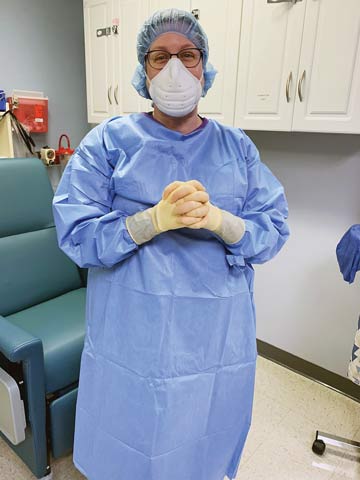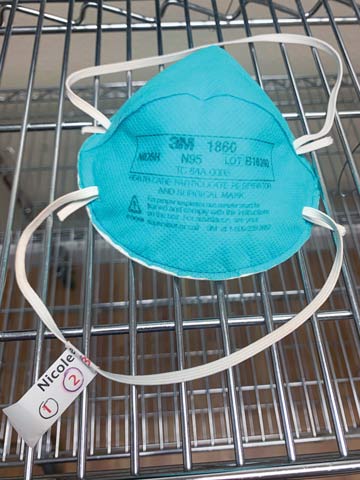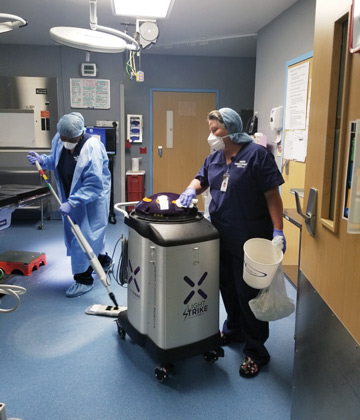November 25, 2024
New York City’s Mount Sinai Health System has opened Peakpoint Midtown West Surgery Center, a 25,106-square-foot multispecialty ASC in Manhattan....
This website uses cookies. to enhance your browsing experience, serve personalized ads or content, and analyze our traffic. By clicking “Accept & Close”, you consent to our use of cookies. Read our Privacy Policy to learn more.
By: Daniel Cook
Published: 6/11/2020
It’s been three months since the coronavirus outbreak shuttered outpatient operating rooms across the country, leaving surgical professionals to wonder how long the hiatus would last and what surgery would be like when they returned. They’re about to find out as elective procedures are beginning to resume in communities where COVID-19 cases are on the decline.
Reopening a facility is more involved than switching on the surgical lights and firing up the autoclave. It demands a slow build back to relative normalcy due to local health department restrictions and the practicality of performing surgery under new policies and procedures that have disrupted well-honed routines.
When Florida’s governor reopened parts of the state in early May, Nikki Williams, RN, CNOR, began to plan a soft opening of the Lakeland (Fla.) Surgical & Diagnostic Center (LSDC). She spent five long days and late nights huddling with the facility’s clinical leaders to develop reopening protocols.
“It’s a fluid policy that we alter almost daily in response to the changing circumstances associated with the virus,” says Ms. Williams, the center’s clinical director. “Flexibility has been key.”
William H. Marx, DO, is heading the surgery restart efforts at Upstate University Hospital in Syracuse, N.Y. He’s tasked with ensuring elective procedures are relaunched safely and appropriately in two large hospitals and two surgery centers. It’s been a slow and steady ramp up.
“We’re moving cautiously,” says Dr. Marx. “We’re going as fast as it’s safe to do. Everyone is appropriately anxious and trying to follow our local health department’s requirements for social distancing and mask wearing.”

Karen Curley, RN, nursing director of procedural services at UConn Health Surgery Center in Farmington, Conn., is helping to reopen the facility, which stopped hosting elective procedures on March 17. Nearly a month later, the center began to gradually add elective cases.
“The decision to start slowly was made in the interest of staff and patient safety, the availability of COVID-19 testing and adequate levels of PPE supplies,” says Ms. Curley. “We wanted to make sure we had all the necessary resources in place.”
You know what they say about best laid plans.
“Testing has been hit or miss,” says Ms. Williams. “We’ve waited up to nine days for results. We thought securing testing in time would be an easy process, and did not anticipate the delays we’re seeing.”
She thinks the clinic was unprepared for the overwhelming demand for screening when the state began to reopen and the strain that put on the local lab responsible for processing the tests. In hindsight, Ms. Williams believes she could have communicated more clearly with the clinic about their testing process.
LSDC now sends patients who don’t have tests completed within 24 hours of their procedures to the local hospital, which can provide results within five hours. “We’re paying for the rapid turnaround, but we’re keeping cases on the schedule and the patients are getting their surgeries done,” says Ms. Williams.
The facility’s online registration portal now includes questions about possible COVID-19 exposure and symptoms, which staff review during the pre-screening process. On the day of surgery, patients are screened at a makeshift station set outside the center’s main doors. They’re asked to sign a COVID-19 form, on which they acknowledge the procedure they are about to undergo is elective and they are incurring some risk by entering the facility.
On the form, a staff member notes patients’ responses to questions about their possible exposure to COVID-19 and symptoms of the virus they might be experiencing, including cough, shortness of breath and fatigue.
The staff member conducting the screenings takes patients’ temperature readings and oxygen saturation levels, and notes them on the form. A case is immediately canceled if a patient has a temperature of 99.5 degrees or higher or an oxygen saturation level of 94% or less, which is an indicator of COVID-19 pneumonia. In some cases, patients can schedule an urgent chest X-ray, which, if clear, would allow the procedure to proceed
.LSDC’s staff members and surgeons have their temperatures taken and answer questions about possible exposure to COVID-19 before entering the facility each day.
Dr. Marx says Upstate Hospital’s patients must be tested within 24 and 72 hours of their surgeries, a tighter window that works due to the health system’s resources. However, testing has been difficult to complete for the large numbers of patients who travel several hours for access to surgical care unavailable in their rural communities. “We’re trying to coordinate timely testing with local primary care physicians, but it’s been challenging,” says Dr. Marx.
The results are mixed, according to Ms. Williams. She says the facility’s four ORs have reached the capacity goal, but case volumes in the five GI procedure rooms remain stagnant due to a perfect storm of misfortune: furloughed staff in the clinic that refers patients to the center, delays in securing COVID-19 test results and the retirement of a top-producing physician.

Elective cases were halted at UConn Health Surgery Center on March 17 and began again almost a month later. During the first week back, the center hosted only 12 cases in its five ORs, limiting the scheduled procedures to pain management procedures and hand and wrist surgeries — cases that can be done with local blocks instead of general anesthesia, which increases COVID-19 exposure risks during aerosol-producing intubation and extubation.
“We wanted also to maintain social distancing protocols and stagger start times by 30 minutes to ensure patients didn’t cross paths,” says Ms. Curley.
The center added more involved orthopedic cases, such as shoulder scopes, the second week after reopening and planned to bring all five of its rooms back up to speed on June 1.
“The center’s leadership meets weekly to discuss testing trends and infection rates throughout the state,” says Ms. Curley. “We keep monitoring and rehashing our status.”
Dr. Marx says Upstate Hospital is limiting the number of total cases each of its four facilities can accommodate per day based on PPE burn rates and the additional time it takes to terminally clean ORs between cases.
“Surgeons want what they want when they want it,” says Dr. Marx. “We’re trying to accommodate all their requests.”
Upstate’s surgeons are working through a backlog of approximately 1,500 cases, a reasonable amount when it’s broken down across several facilities and specialties. “We expect to be back to normal capacity sometime between August and January, depending on the incidence of COVID-19 in our community and possible state restrictions that would require us to slow down,” says Dr. Marx.
During procedures involving aerosolization, which can occur during upper endoscopies and intubation/extubation, staff at LSDC must wear face shields and isolation gowns in addition to N95 masks. The center currently has adequate supplies of PPE, but shortages are a constant concern.
“Materials management is in constant communication with clinical staff members, who provide a running total of PPE supplies,” says Ms. Williams. “We’ve fulfilled requests based on daily needs.”

In addition to wearing a surgical mask over an N95 mask, staff at UConn Health Surgery Center must wear a face shield whenever they interact with patients, including in pre-op and the PACU.
Patients at both surgery centers are required to wear masks at all times during their stay.
The surgery center’s staff have also been instructed to regularly clean high-traffic areas. When patients leave the lobby for the pre-op area, the chair where they sat must be thoroughly cleaned before another patient can occupy it. All surfaces in pre- and post-op bays, including equipment and mobile computer stations, are wiped down between patients. “Our staff has always been careful about cleaning surfaces,” says Ms. Williams, “but we reemphasized the importance of being more diligent than ever.”
When surgical facilities shut down in the middle of March, no one could predict when surgeries would begin again or how they would be performed when they did. “We shut down immediately and came back to a completely different way of doing things,” says Ms. Williams. “It’s a whole new world.”
For some, returning to work under these circumstances feels a bit disjointed. “It’s been strange to allow only three people in elevators, to take a wide berth around colleagues in hallways and break up gatherings at the surgical department’s front desk,” says Dr. Marx. “But we’re moving forward as best we can.”
For others, time spent away from the OR has made the return that much sweeter.
“I can’t say enough good things about how my team is handling the changes,” says Ms. Curley. “Surgery is different now and it might never be the same. But we all have a greater appreciation for working together again as a team. We’re not taking that for granted. OSM
New York City’s Mount Sinai Health System has opened Peakpoint Midtown West Surgery Center, a 25,106-square-foot multispecialty ASC in Manhattan....
The new Irrisept Accessory Kit, now available for use with Irrisept Antimicrobial Wound Lavage, provides clinicians with more ways to use the trusted irrigation device....
As a leader, you need to look ahead for long-term solutions to an ever-changing environment while at the same time dealing with daily challenges....